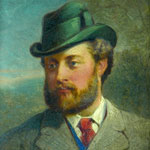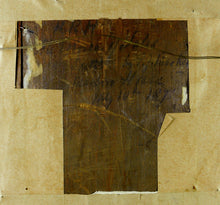Portrait of The Prince of Wales, 1871
Adding product to your cart
Image: 19cm (7.5in) x 14cm (5.5in)
Oil on panel. Inscribed verso ‘H.R.H. / The Prince of Wales / sketch by T.J. Barker / July 10th 1871’. Contained in period frame 42cm (16.5in) x 37cm (14.5in).
The present portrait is a preliminary sketch for a subscription painting entitled ‘The Spa Promenade’ (now in Scarborough Town Hall) commissioned by the Canadian-born, New York-trained photographer Oliver François Xavier Sarony (1820-1879). A consummate showman, Sarony operated at Scarborough what was said to be the largest photographic establishment in Europe, and offered his clients a portraiture service in oils from a string of established artists including Jones Barker.
Read more
‘The Spa Promenade’ was in part a celebration of the Prince of Wales’s patronage of Sarony and Scarborough at large - the Prince being a regular grouse shooting guest at the Earl and Countess of Londesborough’s cliff top villa, Londesborough Lodge. Furthermore it was also a scheme by which Sarony could charge selected patrons a fee for inclusion in the group centered around the figure of the Prince. Jones Barker’s sketch is itself based on a photograph probably taken by Sarony of the thirty-one year-old Prince in a shooting attire, lolling against a tree with a gun and wearing the type of hat that he had recently adopted on a gambling spree in Bad Homburg. In 1871 there was considerable anti-monarchist sentiment in England. A fact that was not helped by the Prince’s latest antics in Paris where a blackmailer was threatening to expose a cache of compromising letters and photographs, while concerned courtiers at home were hushing up an illegal bare-knuckle fight said to have been organised by Bertie and his friends.
Thomas Jones Barker (1815-1882) was born at Bath, the son of the painter Thomas Barker. He studied in Paris under Horace Vernet in 1835-45 and exhibited at the Salon and the Royal Academy, becoming known as a painter of historical and contemporary military events. Arguably his most famous painting, ‘The Secret of England’s Greatness’ is now considered a controversial image by the curatorial staff at Tate Britain where it is currently on show as part of their ‘Artist and Empire’ exhibition. Other significant works by Barker include ‘The Relief of Lucknow’ was shown to Queen Victoria in May 1860. ‘The Bride of Death’ (1840) - weirdly, painted for Princess Marie, the youngest daughter of King Louis Phillipe and for which TJB received the Legion d’Honneur; ‘The Meeting of Wellington and Blucher (1851); ‘Wellington Crossing the Pyrenees’ (1857); ‘The Mêlée - Charge of Cuirassiers and Chasseurs’ (1872); ‘Balaklava - One of the Six Hundred’ (1874); ‘The Return through the Valley of Death’ (1876); ‘Major General Williams and His Staff Leaving Kars 28 Nov. 1855’ (1857); and ‘Riderless War-Horses after the Battle of Sedan’ (1873).
Sources:
Liverpool Daily Post, 2 November 1869. Report of P.o.W visiting Sarony
Clarke, S. (2014) Dirty Bertie: An English King Made in France, Century, Random House London
Ridley, J. (2012) Bertie: A Life of Edward VII






